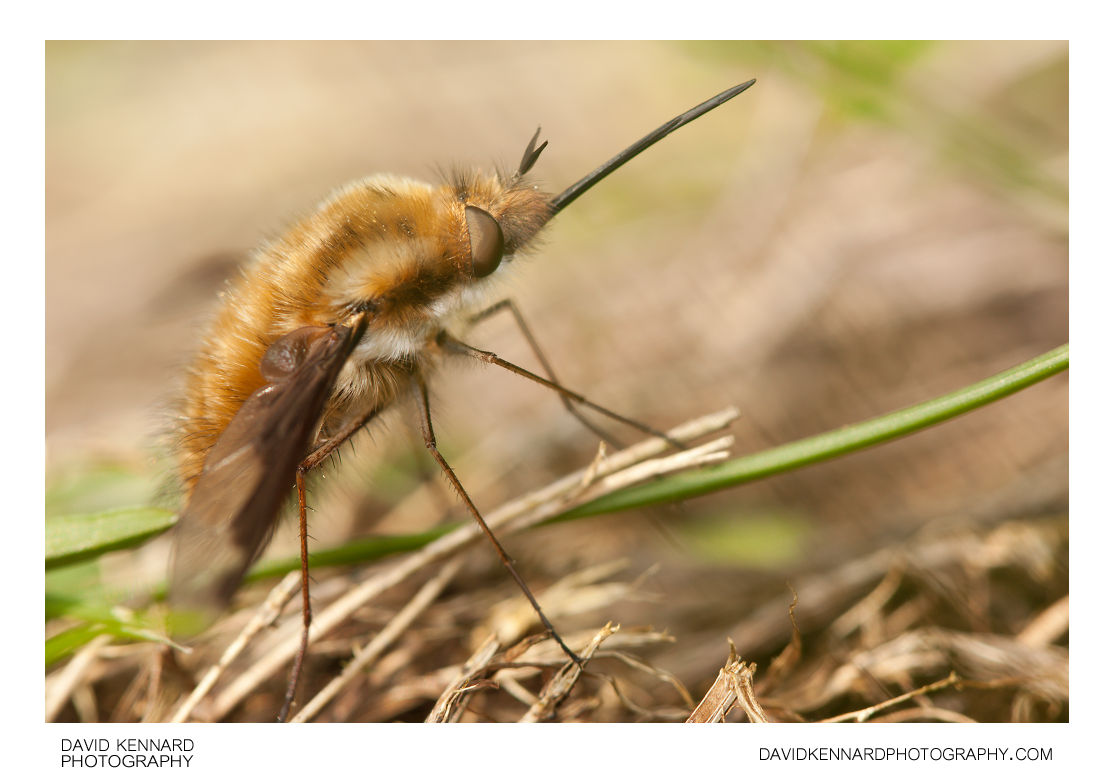Greater Bee Fly Bombylius major

Description
- Title:
- Greater Bee Fly Bombylius major
- Caption / Description:
-
A Greater Bee Fly (Bombylius major) rests in the sun on a patch of grass.
The large bee fly, Bombylius major, is a bee mimic. The eggs are flicked by the adult female toward the entrance of the underground nests of solitary bees and wasps. After hatching, the larvae find their way into the nests to feed on the grubs.
The adult is 14 to 18 mm in length, squat and very hairy, with a wingspan of around 24 mm. It has dark patches on the anterior half of the wings and long hairy legs that dangle while in flight. Bee flies are expert flyers, and their hovering habit has led to their being incorrectly called a species of hoverfly (Syrphidae). The very long proboscis is used to feed on the nectar of many species of flower, especially primroses.
Bombylius major can be found in April to June throughout temperate Europe and North America and some parts of Asia.
Description from Wikipedia: http://en.wikipedia.org/wiki/Bombylius_major
- Tags / Keywords:
-
- Biota
- Life
- Vitae
- Eukaryota
- Animalia
- Animals
- Arthropoda
- Arthropods
- Insecta
- Insects
- Diptera
- Flies
- Bombyliidae
- Bee flies
- Bombylius
- Bombylius major
- Greater Bee Fly
Admin
- Date Original Photo Taken:
- Original File Name:
- _MG_2702.CR2
- Event:
- Rating:
- ☆
- Date this image added/last updated on website:
- Original File Dimensions:
- 4272px x 2848px
- File Type:
- JPEG
- Color Mode:
- Original Image Color Profile:
- Adobe RGB (1998)
Location
- Location Created:
-
- Sublocation:
- City:
- Market Harborough
- Province/State:
- Leicestershire
- Country:
- United Kingdom
- World Region:
- Europe
- Geo-location:
Rights
- Copyright Status:
- Copyrighted
- Licensing Status:
- Rights Managed
- Available for Editorial Use:
- Yes
- Available for Commercial Use:
- Yes
- Copyright Notice:
- © 2012 Dave Kennard
Camera Data
- Date Digital Resource was created:
- Shutter speed:
- 1⁄160 s
- Aperture:
- f/5.6
- Camera Model:
- Canon EOS 450D
- ISO:
- 200
- Exposure Compensation:
- 0
- Focal Length:
- 100mm
- Focal Length (35mm equiv.):
- Metering Mode:
- Multi-segment
- Flash:
- On, Fired
- Exposure Mode:
- Manual
- White Balance:
- Manual
- Light Source:
- Exposure Program:
- Manual
Additional shooting metadata
- Lens:
- Canon EF 100mm F2.8 Macro USM
- Filters used:
- Additional Optics used:
- Setup:
- Handheld
Canon MT-24EX Macro Twin Flash
Post Processing
- Image Modified:
- Software used:
-
- Adobe Camera RAW
- Post Processing:
-0.15 exposure compensation in ACR
6 recovery in ACR
